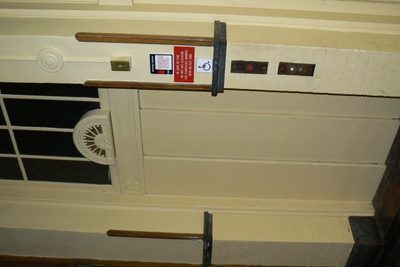City Hall in Jersey City has what looks like two elevators in operation. But in reality, one of them is not working – and it has been that way since 1979.
It is the result of the afternoon fire that destroyed the top floor of City Hall in September of 1979, the cause of which remains a mystery to this day. Besides damage to various sections of the municipal building, the elevator shaft was damaged. Thus, the elevator has remained out of commission since that time.
The reconstruction of City Hall cost the city an estimated $2 million. That included the city spending movie over the next five years to build new offices on the third floor and eventually to construct an entirely new roof.
One of the elevators at City Hall has been out of service for 30 years.
________
The only two ways to move up and down the three floors in the building are to use the one operating elevator or the stairs.
Employees in City Hall said that as long as they had been working there, there has been only one elevator in operation. One employee said he had seen inside the elevator doors, and there was only a shaft. Other employees said they didn’t even notice there was a second elevator next to the one that works.
However, a 27-year employee Robert Byrne, the City Clerk, said when he first started in 1982, there were no elevators working and it took two years to install the one elevator that is working, which he said was an extensive task.
Should there be a second working elevator in operation, and is the city doing something about it?
City spokesperson Jennifer Morrill said last week that the city’s architecture division is currently studying the possibility of installation of a second elevator as part of a larger plan to renovate City Hall.
One elevator is enough
Lisa Ryan, the spokesperson for the New Jersey Department of Community Affairs, under which the Elevator Safety Unit registers all elevator devices in the State of New Jersey, said that the elevator can remain out of order under two conditions: If City Hall was built prior to 1977, predating the state’s Uniform Construction Code, and if the original Certificate of Occupancy for the building did not require two elevators.
Ryan said that there is a way of placing an elevator out of service that involves disconnecting power and securing the car at ground level. If it does not create any potential hazards, then it does not constitute a violation of the state’s code.
However, Ryan notes, if the out-of-service elevator provided access to a portion of the building that is not reached by the lone elevator in service, the loss of the out-of-service elevator might constitute a violation of the Americans with Disabilities Act (ADA).
“There is more than one way to achieve [compliance],” Ryan said. “The [state] is not the final arbiter of compliance with the ADA; it is federal civil rights legislation enforced through litigation.”
Ricardo Kaulessar can be reached at rkaulessar@hudsonreporter.com.
